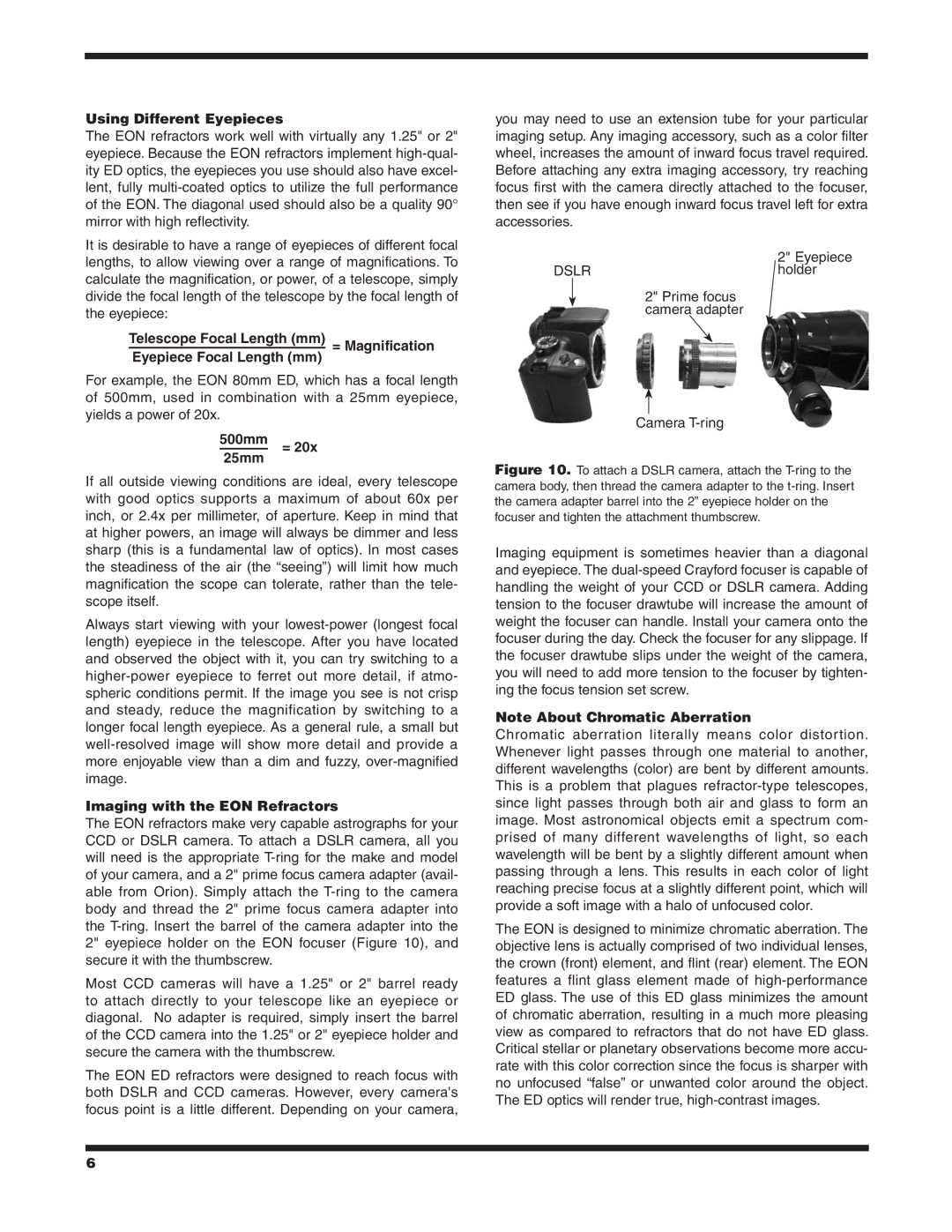Using Different Eyepieces
The EON refractors work well with virtually any 1.25" or 2" eyepiece. Because the EON refractors implement high-qual- ity ED optics, the eyepieces you use should also have excel- lent, fully multi-coated optics to utilize the full performance of the EON. The diagonal used should also be a quality 90° mirror with high reflectivity.
It is desirable to have a range of eyepieces of different focal lengths, to allow viewing over a range of magnifications. To calculate the magnification, or power, of a telescope, simply divide the focal length of the telescope by the focal length of the eyepiece:
Telescope Focal Length (mm) = Magnification
Eyepiece Focal Length (mm)
For example, the EON 80mm ED, which has a focal length of 500mm, used in combination with a 25mm eyepiece, yields a power of 20x.
500mm = 20x 25mm
If all outside viewing conditions are ideal, every telescope with good optics supports a maximum of about 60x per inch, or 2.4x per millimeter, of aperture. Keep in mind that at higher powers, an image will always be dimmer and less sharp (this is a fundamental law of optics). In most cases the steadiness of the air (the “seeing”) will limit how much magnification the scope can tolerate, rather than the tele- scope itself.
Always start viewing with your lowest-power (longest focal length) eyepiece in the telescope. After you have located and observed the object with it, you can try switching to a higher-power eyepiece to ferret out more detail, if atmo- spheric conditions permit. If the image you see is not crisp and steady, reduce the magnification by switching to a longer focal length eyepiece. As a general rule, a small but well-resolved image will show more detail and provide a more enjoyable view than a dim and fuzzy, over-magnified image.
Imaging with the EON Refractors
The EON refractors make very capable astrographs for your CCD or DSLR camera. To attach a DSLR camera, all you will need is the appropriate T-ring for the make and model of your camera, and a 2" prime focus camera adapter (avail- able from Orion). Simply attach the T-ring to the camera body and thread the 2" prime focus camera adapter into the T-ring. Insert the barrel of the camera adapter into the 2" eyepiece holder on the EON focuser (Figure 10), and secure it with the thumbscrew.
Most CCD cameras will have a 1.25" or 2" barrel ready to attach directly to your telescope like an eyepiece or diagonal. No adapter is required, simply insert the barrel of the CCD camera into the 1.25" or 2" eyepiece holder and secure the camera with the thumbscrew.
The EON ED refractors were designed to reach focus with both DSLR and CCD cameras. However, every camera's focus point is a little different. Depending on your camera,
you may need to use an extension tube for your particular imaging setup. Any imaging accessory, such as a color filter wheel, increases the amount of inward focus travel required. Before attaching any extra imaging accessory, try reaching focus first with the camera directly attached to the focuser, then see if you have enough inward focus travel left for extra accessories.
| | 2" Eyepiece |
DSLR | holder |
| | 2" Prime focus |
| |
| | camera adapter |
Camera T-ring
Figure 10. To attach a DSLR camera, attach the T-ring to the camera body, then thread the camera adapter to the t-ring. Insert the camera adapter barrel into the 2” eyepiece holder on the focuser and tighten the attachment thumbscrew.
Imaging equipment is sometimes heavier than a diagonal and eyepiece. The dual-speed Crayford focuser is capable of handling the weight of your CCD or DSLR camera. Adding tension to the focuser drawtube will increase the amount of weight the focuser can handle. Install your camera onto the focuser during the day. Check the focuser for any slippage. If the focuser drawtube slips under the weight of the camera, you will need to add more tension to the focuser by tighten- ing the focus tension set screw.
Note About Chromatic Aberration
Chromatic aberration literally means color distortion. Whenever light passes through one material to another, different wavelengths (color) are bent by different amounts. This is a problem that plagues refractor-type telescopes, since light passes through both air and glass to form an image. Most astronomical objects emit a spectrum com- prised of many different wavelengths of light, so each wavelength will be bent by a slightly different amount when passing through a lens. This results in each color of light reaching precise focus at a slightly different point, which will provide a soft image with a halo of unfocused color.
The EON is designed to minimize chromatic aberration. The objective lens is actually comprised of two individual lenses, the crown (front) element, and flint (rear) element. The EON features a flint glass element made of high-performance ED glass. The use of this ED glass minimizes the amount of chromatic aberration, resulting in a much more pleasing view as compared to refractors that do not have ED glass. Critical stellar or planetary observations become more accu- rate with this color correction since the focus is sharper with no unfocused “false” or unwanted color around the object. The ED optics will render true, high-contrast images.

